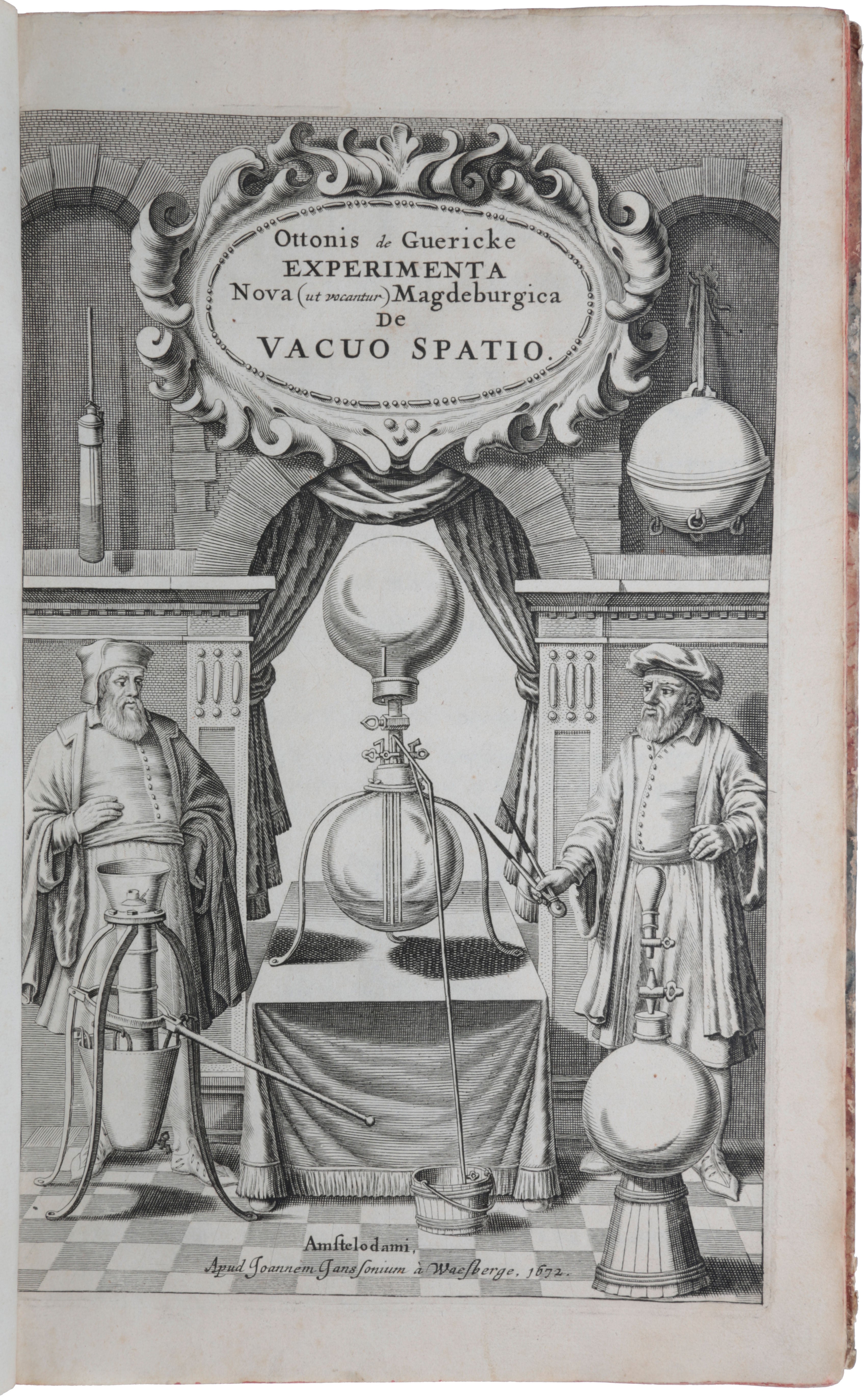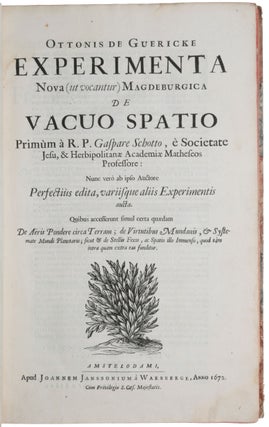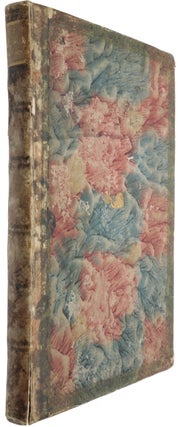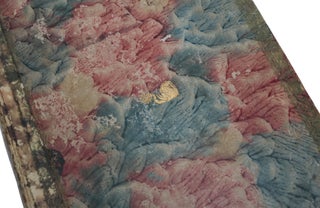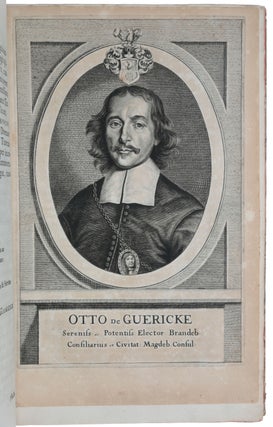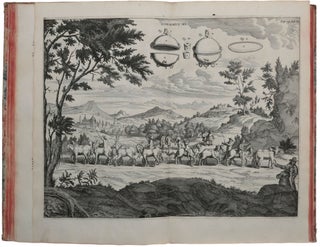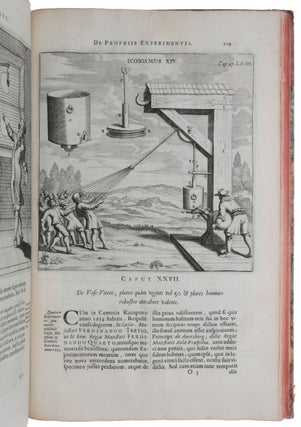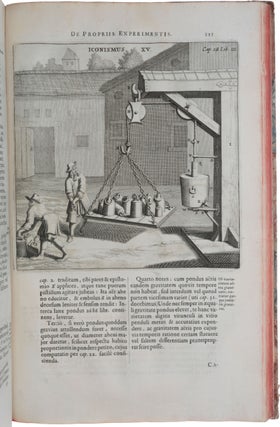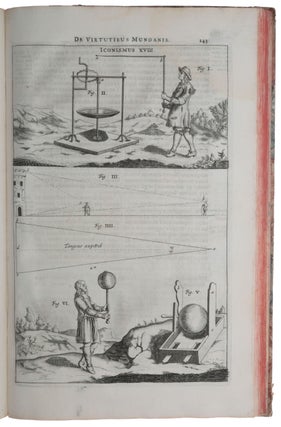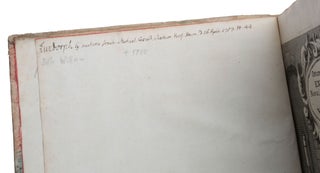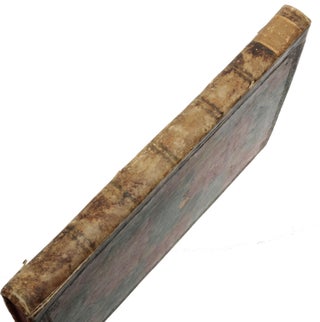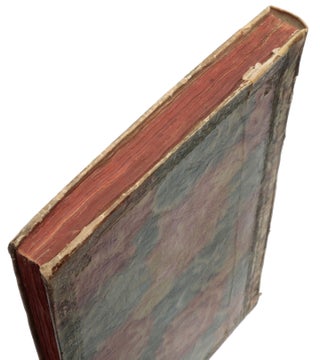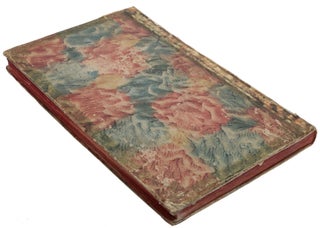Experimenta Nova (ut vocantur) Magdeburgica de Vacuo Spatio Primùm à R.P. Gaspare Schotto . . . nunc verò ab ipso Auctore Perfectiùs edita, variisque aliis Experimentis aucta. Quibus accesserunt simul certa quaedam De Aeris Pondere circa Terram; de Virtutibus Mundanis, & Systemate Mundi Planetario; sicut & de Stellis Fixis, ac Spatio illo Immenso, quod tàm intra quam extra eas funditur.
Amsterdam: Johanned Jansson Waesberge, 1672. First edition of one of the great classics of science. “A book of prime importance in electrical discovery, air-pressure and the vacuum pump” (Dibner). Guericke proved the existence of a vacuum through his famous experiment, illustrated by one of the double-page plates. “At Ratisbon in 1654 Guericke had performed one of the most dramatic experiments in the history of science, when, before the Imperial Diet, he showed how two teams of eight horses each could not separate a bronze pair of hemispheres from which he had exhausted the air” (ibid.). To create the vacuum, Guericke invented the air-pump, and in a series of experiments that followed he demonstrated the weight and elasticity of air. The air-pump became of fundamental importance for the study of the physical properties of gases. Guericke also demonstrated electrical attraction and repulsion, the discharging power of points, and constructed the first electrical generator. “Guericke constructed a spherical rotor of sulphur mounted on a crank; its rotation and contact upon it generated the first visible and audible electric sparks” (ibid.). As the Wheeler Gift catalogue remarks, “This remarkable work on experimental philosophy ranks next to Gilbert's in the number and importance of the electrical discoveries described. Electric conduction and repulsion, the discharging power of points, the dissipation of charge by flames, the light due to electrification, the crepitating noises of small sparks are all recognized”. Guericke’s experiments were motivated by his profound Copernican cosmological views on the nature and composition of space, which are fully set forth in the present work. Provenance: inscription by the bibliophile by the Bolle Willum Luxdorph (1716-1788), documenting his purchase of the book, 14 April 1787, at the auction sale of mathematician Joachim Michael Geuss (1745-1786). Later owned by the famous German collector Otto Schäfer (1912-2000), whose collection of books formed one of the most important private libraries of the twentieth century. “Guericke had been preoccupied ever since his student days at Leiden with the question of the definition of space. A convinced Copernican, he was particularly concerned with three fundamental questions: (1) What is the nature of space? Can empty space exist, or is space always filled and empty space only a spatium imaginarium, a logical abstraction? (2) How can individual heavenly bodies affect each other across space, and how are they moved? (3) Is space, and therefore the heavenly bodies enclosed in it, bounded or unbounded? “Descartes’s conception of space and matter as equivalent and his denial of a vacuum led Guericke to propose an experiment designed to resolve the old conflict between plenists and vacuists. Guericke posited that if the air were pumped out of a strong container and no other new material allowed to take its place the vessel would implode if Descartes’s assertions were true. Soon after he returned from Osnabruck in 1647 Guericke made a suction pump using a cylinder and piston to which he added two flap valves; he then used this apparatus to pump water out of a well-caulked beer cask. Air entered the cask, however, as was evidenced by whistling noises. When Guericke repeated the experiment with the beer cask sealed within a second larger one that he had also filled with water, the water that he pumped out was replaced by water seeping in from the larger vessel. “In an attempt to solve the sealing problem Guericke ordered the construction of a hollow copper sphere with an outlet at the bottom. He pumped the air directly out of this apparatus which thereupon imploded. This result would seem to indicate that Descartes was right; but Guericke still thought otherwise on the basis of his earlier experiments. He had a new apparatus made, and with this his experiment succeeded. Guericke thus invented the air pump, or, rather, discovered the pumping capacity of air. He had thought that the air within the vessel would sink, as had the water in his previous devices, and that it would be evacuated from the bottom; later experiments, however, in which the outlet was placed at arbitrary points on the copper sphere proved that the air left in the container during the process of evacuation was distributed evenly throughout the interior space. “This discovery of the elasticity of the air represents perhaps the most important result of Guericke's experiments. From it he was led to investigate the decrease of the density of the air with height and to theorize concerning empty space beyond the atmosphere of heavenly bodies; to study variations of air pressure corresponding to changes in the weather (taking mean air pressure to correspond to a water column twenty Magdeburg ells high, he succeeded in 1660 in making barometric weather forecasts); to propose systematic weather reporting through a network of observation stations; to come to know the ponderability of air within air; and finally, to draw further conclusions about a variety of phenomena connected with vacuums, most of which he demonstrated experimentally, especially the work capacity of air, by which he refuted the theory of horror vacui. “The most famous of Guericke's public experiments is the one of the Magdeburg hemispheres, in which he placed together two copper hemispheres, milled so that the edges fit together snugly. He then evacuated the air from the resulting sphere and showed that a most heavy weight could not pull them apart. Contrary to legend, the demonstration was performed with a team of horses for the first time in Magdeburg in 1657 (not Regensburg in 1654) and repeated at court in Berlin in 1663. Guericke also made other, less dramatic, public demonstrations of the effective- ness of air pressure on several occasions in Regensburg; these Regensburg experiments were reported by Gaspar Schott in Mechanica hydraulico-pneumarica (1657) and Technica curiosa (1664), and were supplemented with additional information that Guericke communicated by letter. “Schott's books as well as other foreign publications of Guericke's experiments (for example, works of M. Cornaeus and S. Lubieniecky) stimulated Huygens and Boyle, among others, to repeat and extend the experiments and to set to work upon an improved air pump. Guericke himself was occupied with the same project; he improved his pump with hydraulic sealing and devised a stationary installation for it (it occupied two floors of his house). In 1663 Guericke developed a portable pump modeled on one of Boyle's and constructed one especially for his visit to Berlin in that year. (Three examples of this type of pump survive, one each in Munich, Lund, and Brunswick.) “Guericke's experimental work, however, represents only one facet of his attempt to reach a complete physical world view. He drew upon his Copernicanism to construct the foundations for such a system. Guericke’s celestial physics were further based upon the notion that the heavenly bodies interacted with each other across empty space through magnetic force; here he turned to the earlier work of Gilbert and Kepler. Their magnetic hypotheses had been refuted by Athanasius Kircher (in Magnes sive De arre magnerica, 1641); joining the argument, Guericke sought to modify Gilbert's magnetism experiments by making use of materials mimicking the actual composition of the earth. To this end Guericke cast a sphere composed of a variety of minerals with a large proportion of sulfur — in later experiments he used pure sulfur — and showed that it possessed the virrures mundanae, that is, such powers as attraction and the ability to move other bodies. By rubbing the sphere of sulfur, Guericke had actually produced static electricity; but since he did not recognize these electrical effects as special phenomena, but as demonstrations of the virtutes of a celestial body, he cannot properly be credited with the invention of the first electrical machine. “Having dealt with the problems of empty space and the movement of heavenly bodies, Guericke concerned himself further with the question of the boundedness of space and the number of worlds therein. He conceived of fixed stars as suns with planetary systems, each of which exerts a sphere of force (orbis virrutis, sphaera acrivitaris); these systems border on each other and do not interact — each heavenly body rather possesses a specific center of gravity for a specific virrus conservariva, which he interpreted as its source of cohesion. Thus, in opposition to Aristotelian cosmography, an immaterial boundary of space becomes inconceivable. Giordano Bruno had already speculated about an infinite universe containing an infinite number of worlds, but his ideas had been unacceptable because only God was considered infinite — all of God's creation must be finite. Guericke overcame this objection by re- defining the notion of nothingness. By his reasoning, empty space as a mere receptacle for God's creations is nothingness and is not created. Empty space is therefore independent of God and the created universe — indeed, it precedes the latter. Therefore empty space cannot be bounded. Neither can the number of worlds be bounded, although such a number is not infinite (since there are no infinite numbers). Likewise it is not limited, since there is no greatest number and no end to the series of numbers. Infinite space is thus a conceptual possibility. “Such speculations about the heavenly bodies quite naturally led Guericke to the study of astronomy. He explained planetary orbits as exactly circular and concentric, effected by the rotating orbis virtutis of the sun, and interpreted the apparent eccentricities as a result of the different densities of the atmosphere” (DSB). Dibner, Heralds of Science, 55 (pp. 30 & 67); Dibner, Founding Fathers of Electrical Science, pp. 13-14; DSB V.574-76; Evans, Exhibition of First Editions of Epochal Achievements in the History of Science (1934), 30; Horblit 44; Norman 952; Parkinson, Breakthroughs, pp. 112-3; Sparrow, Milestones of Science, p. 16; Wheeler Gift 170.
Folio (324 x 202 mm), pp. [xvi, including the engraved title], 244, [6], with engraved title, engraved portrait of the author, two double-page engraved plates, and 21 engraved plates in text, many full-page (plate XVIII repeated, as is correct). Eighteenth-century pastepaper boards, roll-tooled gilt border and corner-pieces, gilt supralibros of elephant head supporting a coronet with its trunk, marbled endpapers, mock calf paper spine label, edges stained red. Some light dampstaining, corner loss to one leaf. Binding rubbed, gilt tooling faded; portrait possibly supplied from another copy and tipped in.
Item #5796
Price: $65,000.00

